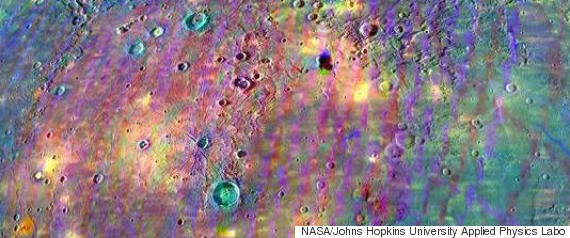
http://www.huffingtonpost.com/2015/...7034.html?utm_hp_ref=weird-news&ir=Weird News
NASA's MESSENGER spacecraft is out of fuel and expected to crash into Mercury this week.
“At the end of this month, we will lose our battle with solar gravity and we’ll come in at 3.9 kilometers a second, which is about 8,700 miles per hour," Helene Winters, MESSENGER project manager, said in a statement released by NASA.
As part of a celebration of the spacecraft's successful mission, the space agency released stunning new images showing the solar system's smallest planet as it has never been seen before: awash in color.
The trippy burst of colors isn't what the planet would look like to the human eye.
The spacecraft's Mercury Atmosphere and Surface Composition Spectrometer (MASCS) captures hundreds of wavelengths of light, many invisible to us. These wavelengths are then converted to red, green and blue to highlight both physical and chemical differences on the planet's surface, such as minerals, craters and pyroclastic vents.
MASCS data was combined with a monochrome mosaic taken by the Mercury Dual Imaging System to produce the new images.
Here's one portion of the surface up close:

NASA said MESSENGER has snapped some 250,000 images and extensive other data during its four years in orbit:

NASA also released a video, posted at the top of this story, combining animations showing MESSENGER in action with actual images taken by the spacecraft.
The MESSENGER (MErcury Surface, Space ENvironment, GEochemistry and Ranging) spacecraft is expected to hit the planet's surface on Thursday afternoon. While the impact itself will not be visible live, NASA said the crater it will leave behind could provide useful information.
"Having an impact crater, even a small one, whose origin date is precisely known, will be an important benchmark," Sean Solomon, the mission’s principal investigator and director of Columbia University's Lamont-Doherty Earth Observatory in New York, told Space.com earlier this month.
MESSENGER was launched in 2004 and entered the planet's orbit on March 18, 2011. In 2012, it discovered evidence of water ice deposits and other volatile material in craters in the planet's polar regions.
While surface temperatures of Mercury can reach 800 degrees Fahrenheit, the craters remain in darkness, keeping them cool enough for the ice to remain.
A dark layer on the ice is believed to be organic compounds that arrived from the outer solar system via comets and asteroids that crashed into the planet -- and scientists theorize similar impacts may have played a role in the formation of life on Earth.
“[T]he ideas for how the inner planets got assembled, and how the building blocks of planetary materials were delivered to the inner solar system and survived the process of planetary accretion, are all being changed by MESSENGER’s results,” Sean Solomon, MESSENGER principal investigator, said in a statement.
NASA scientists have also created a "Top 10" list of MESSENGER's discoveries, along with videos, which can be seen here.
Thoughts?
